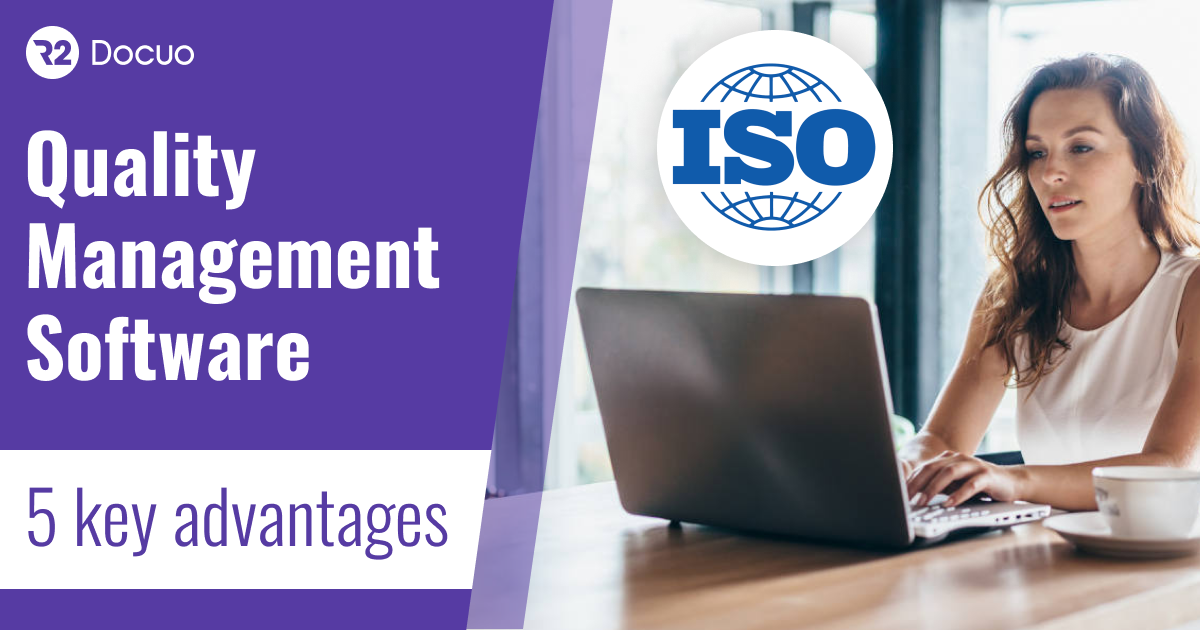
Quality Management Software: The 5 Key Benefits
Quality Management Software is a tool for planning, controlling and improving an organization’s processes to meet international standards.
In the early 1980s, a greater awareness of the importance of quality in business began to emerge. In this decade, major quality management standards such as ISO 9001 and many others began to be developed.
Only recently has attention been paid to the effort involved in proper quality management, if carried out manually, and the benefits of managing it with software.
The problems of manual quality management
The set of procedures, work instructions and review activities (nonconformities and improvement actions, management review, etc.) that a company carries out to adapt to a quality standard is called Quality Management System, which is what auditors actually evaluate when they audit a company.
The most common situation is for quality managers to document and control their management system using basic office automation tools: Word documents in shared folders, Excel sheets for records, and hundreds of emails to exchange information. This is what we call manual (or basic tool) quality management.
Managing Quality manually presents numerous challenges. For starters, human errors when filling in records, creating and collecting nonconformities or checking the effectiveness of improvement actions.
Meeting the standard or just “renewing the seal”?
But perhaps the most serious problem with manual quality management is that it is very difficult to verify that procedures are actually being followed.
Quality manuals are often left “gathering dust” in these shared folders. They are usually not integrated into the day-to-day work of the teams. They are simply not read, or are read only when there are problems, even if the Quality department makes training and awareness efforts.
To make matters worse, when these procedures change, the people concerned must be notified that there is a new version of this or that document and that the change has been understood. This is a pipe dream in many cases.
«…frequently, the Quality Manager finds himself days before the audit reviewing the validity of his records, completing indicators and creating an illusion of compliance»
The result is that, frequently, the Quality Manager finds himself days before the audit reviewing the validity of his records, completing indicators and creating an illusion of compliance that allows him to “renew the seal”.
Regardless of whether the audit is passed or not, the consequence is that the organization does not benefit from true compliance with quality standards and their advantages in improving customer satisfaction.
Advantages of Quality Management Software
Although there are many advantages, we are going to tell you the five most important ones.
1. Task automation
This is perhaps the most important. Complying with the requirements of quality systems usually entails having to carry out a large number of manual and repetitive processes and activities: identification of requirements, planning, document control, non-conformity management, internal auditing, etc.
By using software, many of these processes can be automated, which saves an enormous amount of time. For example, data collection, document management, report generation, task planning, alert scheduling, and assignment of responsibilities, among others, can be automated.
Ideally, work teams should complete the necessary information for the Quality Management System while working in the tool, without excessively interfering with their daily responsibilities.
A Quality Management Software allows this by means of automated workflows that are integrated into the daily work of the teams, recording the actions and, indirectly, ensuring the traceability of the processes.
In this way the Quality Manager can demonstrate compliance without additional effort on the day of the audit.
In addition, process automation helps reduce human error. For example, the software can ensure that required procedures are followed and deadlines are met. If any deadline is approaching, it can raise a warning to prevent it from being exceeded.
The Lead Time Management Software can identify deviations and send alerts to those responsible to take corrective action to avoid problems. All this without requiring anyone to memorize a procedure.
2. Centralization of information
Managing a quality system usually involves handling a large amount of information: policies and procedures, records, audit reports, performance data and any other documentation related to quality management.
By doing it manually, this information is often scattered and even duplicated in different places, and accessing it when needed can be an impossible task. This situation can make it difficult to make decisions and evaluate the quality system.
However, when you have Quality Management Software, you have all the relevant information in one place. You can create queries, filter data, export to Excel and more. This way both you and the people involved can access what you need, quickly and easily.
If that wasn’t enough, they also take care of notifying the right people when the new version of a document is published (distribution lists).
3. Accessibility and collaboration
This feature has become especially important in recent years, as many organizations work remotely.
If you have such a tool, your team will be coordinated at all times. There will be a single shared place to find management system information.
If a procedure is obsolete or if a non-conformity needs to be raised, it can be done directly online using a form, not by downloading and completing a Word template as was done in the 2000s.
4. Real-time information
When you manage quality systems, having real-time information is essential, so that the decisions you make are based on up-to-date data. Software will allow you to monitor records and indicators, as well as detect and correct deviations.
In addition, it can also provide information on performance indicators (KPIs). Although they are not an inherent element of management systems, the latest trend is to include them. KPIs allow managers to monitor whether processes are working according to the organization’s objectives and that, in essence, is Quality.
The software also provides at a glance information on the status of the information (whether it is current, under review, approval, etc.). This information lets your team know what documents are available, who has reviewed and approved them. They can also see when they were distributed, ensuring that the latest version of each piece of information is consulted.
5. Regulatory Compliance
Let’s go to the main function of a Quality Management Software: regulatory compliance. No matter what security standard you have to comply with (ISO 9001, ISO 27001, ENS etc.), it can be adapted to the one you need.
In essence a Quality Management Software is a database that meets the requirements of the standard. This makes it easy, not only to track requirements, but also to demonstrate compliance. This way, on the day of the audit, it will be just another audit.
To ensure compliance, you must complete certain records for each standard. As well as carrying out certain actions over time. In the software, you can quickly check whether these actions are being carried out. You can also set alerts and reminders for them.
How to manage quality systems with software
You already know all the work and mistakes you will save if you have Quality Management Software. However, there are some aspects that must be fixed before you start working with one.
To begin with, you need to have established the objectives you want to achieve; it is essential that you, your team members and the supplier you choose are aligned.
In addition, the people who will be in charge of managing the quality system must have the necessary knowledge to use the software. There is no point in having a powerful tool if you do not dedicate the necessary time to learn how to use it.
Finally, it is important to foster a culture of quality, in which all members of the organization work together to achieve the objectives. In this way, quality is no longer something to be achieved once a year.
Choosing the Best Quality Management Software
In the market you will find two families of Quality Management Software:
Those that we could call “the digitized standard” which are in essence a copy of the standard document with boxes to fill in. This type of solution is based on the idea that all companies can comply with the standard in the same way, by “filling in the same boxes”.
On the other hand, there are more sophisticated solutions based on integrating the requirements of the standard into daily work. Although the second model is more ambitious, the benefits obtained are of a different order of magnitude.
A well-implemented Quality Software like Docuo will make the day of the audit a piece of cake. Your organization will see quality as a daily way of working.




